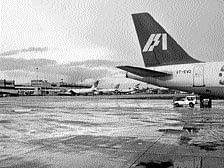'Air India's problem is, it's like a woman with 1000 husbands'

The pilots, he said, had completely covered the windows with newspaper to keep out the sun. “All you had in the cockpit was this yellowish glow, as the light permeated the newspaper,” Haygooni recalled, saying it was a visibility hazard he had never seen in 30 years of flying.
But “this was a normal thing at Air India,” said Haygooni, a former United Airlines pilot who flew for the Indian airline for 16 months. In April 2010, however, he decided that the paycheck was not worth his concerns over what he considered the government’s haphazard approach to running its state-owned airline.
Interviews with more than a dozen experienced pilots hired in the last three years by Air India to work new international routes describe an airline with problems. But theirs are not the only complaints.
Passengers have abandoned Air India in droves, shunning the airline because of its reputation for poor customer service and late flights. Formerly this nation’s monopoly carrier, Air India has been surpassed by three commercial Indian airlines — Jet Airways, Kingfisher and IndiGo — among those that have sprung up since India deregulated the domestic industry nearly two decades ago. Air India now has less than 15 per cent of India’s domestic air travel market, with many empty seats on the flights that do take off.
As a result, Air India lost more than $1 billion in taxpayer money in the last fiscal year. And now there is a growing public clamour for the government to get out of the airline business.
Spokesmen for Air India defend the airline as safe and say it is working to correct its problems. And the nation’s new civil aviation minister, Vayalar Ravi, vowed in an interview on Wednesday not to close or sell the airline. “There is no question of Air India being shut or privatised,” he said. He said vested interests who “want to exploit the people for their own profit” were behind suggestions that India’s government give the airline up.
Still, Ravi said the airline had been mismanaged in the past — including the merging in 2007 of India’s domestic and international state-run airlines. “Nothing positive came out of the merger,” he said, and Air India has bought too many planes. But the airline does “not make any compromises with maintenance and security,” Ravi said.
Air India’s image was not helped by a recent 10-day pilots’ strike over salaries. It ended with a government pledge to raise pay — but not before the work stoppage had caused cancellation of nearly 1,500 flights and added almost $50 million to Air India’s mounting losses.
Hoping to win back customers, Air India is slashing fares and planning to expand, even though it loses money on 95 per cent of its flights. Analysts say the prospect of a fare war threatens to destabilise the entire Indian airline industry and to erase the previous predictions by private carriers of profits this year.
Government control
Even inside the company, some executives are quietly calling for the end of government control. But Air India is popular with India’s central government because ministers and politicians can demand routes to connect their home states with the capital, New Delhi, even if they lose money. “I feel like a woman with 1,000 husbands,” one male Air India executive complained, referring to the constant demands from government officials.
Airlines here responded to the shortage by hiring expatriates, including hundreds from the United States, where — until the rules changed in 2007 — commercial pilots were forced to retire at age 60. In India, as most everywhere else, the retirement age has long been 65.
For many of those who joined Air India, the culture clash has been severe. Dozens left before their three-year contracts expired. Of the 186 foreign pilots hired since April 2007, Air India has just 36 left, the company said.
Air India, with its subsidiary, Air India Express, has about 1,600 pilots and a fleet of more than 120 aircraft making more than 300 flights a day. But pilots’ schedules are still made by pencil in a giant ledger. And to accommodate high-ranking captains, last-minute schedule revisions are so frequent that some pilots call the practice ‘schedule by wake-up call.’ An Air India spokesman in Mumbai, K Swaminathan, confirmed that the company’s rosters were not yet computerised and that changes were often made by hand. But he denied that the scheduling system created safety issues.
Air India was free of major accidents for a decade — until a May 2010 crash in Mangalore that killed 158 people. The captain, a Serbian, came into the landing too high and did not abort it when he should have, the Indian government’s investigation report said. The co-pilot, the report found, “failed to challenge any of the captain’s errors.”
Just four days later, Air India had another serious incident, when a co-pilot, while adjusting his seat, accidentally knocked the controls off their settings as the captain was heading for the bathroom. The plane dropped 7,000 feet before the captain could return to the cockpit and right it.
A government investigation concluded the co-pilot “probably had no clue how to tackle this kind of emergency.”
Deccan Herald is on WhatsApp Channels| Join now for Breaking News & Editor's Picks